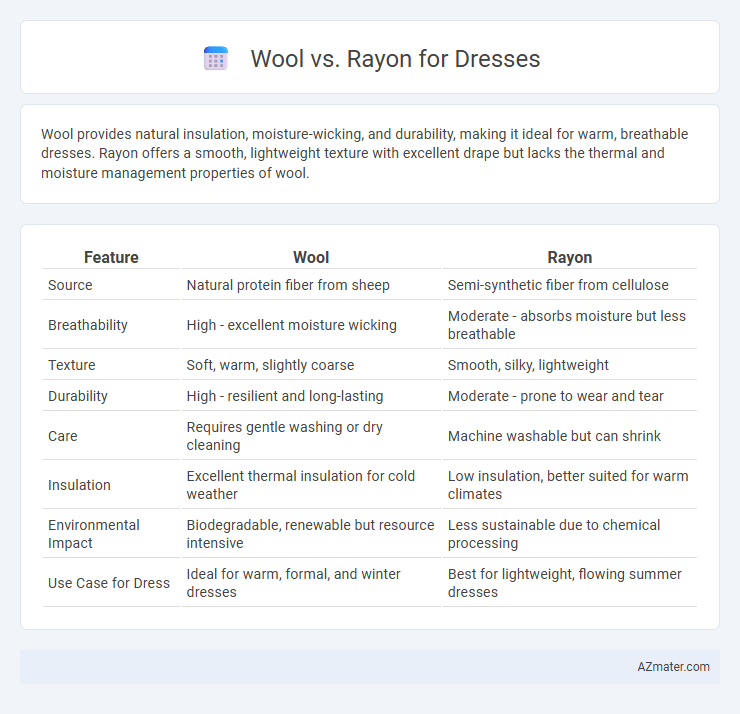Wool provides natural insulation, moisture-wicking, and durability, making it ideal for warm, breathable dresses. Rayon offers a smooth, lightweight texture with excellent drape but lacks the thermal and moisture management properties of wool.
Table of Comparison
| Feature | Wool | Rayon |
|---|---|---|
| Source | Natural protein fiber from sheep | Semi-synthetic fiber from cellulose |
| Breathability | High - excellent moisture wicking | Moderate - absorbs moisture but less breathable |
| Texture | Soft, warm, slightly coarse | Smooth, silky, lightweight |
| Durability | High - resilient and long-lasting | Moderate - prone to wear and tear |
| Care | Requires gentle washing or dry cleaning | Machine washable but can shrink |
| Insulation | Excellent thermal insulation for cold weather | Low insulation, better suited for warm climates |
| Environmental Impact | Biodegradable, renewable but resource intensive | Less sustainable due to chemical processing |
| Use Case for Dress | Ideal for warm, formal, and winter dresses | Best for lightweight, flowing summer dresses |
Introduction to Wool and Rayon Fabrics
Wool, a natural fiber derived from sheep, offers excellent insulation, moisture-wicking properties, and durability, making it ideal for dresses that require warmth and structure. Rayon, a semi-synthetic fiber made from regenerated cellulose, provides a lightweight, breathable, and smooth texture, often used for flowy and comfortable dress designs. Both materials vary significantly in their origins and characteristics, influencing dress style, comfort, and care requirements.
Origin and Production of Wool
Wool originates from the fleece of sheep, primarily sourced from breeds like Merino, prized for fine fiber quality, and is harvested through shearing during specific seasons to ensure sustainable regrowth. The production process involves cleaning, carding, spinning, and weaving to transform raw fibers into durable, insulating fabric favored for dressmaking due to its natural warmth and moisture-wicking properties. In contrast, rayon is a semi-synthetic fiber derived from cellulose, typically wood pulp, undergoing chemical processing to create a versatile fabric that mimics the softness of natural fibers but lacks the inherent breathability and thermal regulation of wool.
Origin and Production of Rayon
Rayon is a semi-synthetic fiber derived from regenerated cellulose, primarily sourced from wood pulp, bamboo, or cotton linters through a chemical process called viscose or lyocell production. Wool, on the other hand, originates naturally from the fleece of sheep, harvested through shearing without chemical alteration. The industrial-scale production of rayon involves dissolving cellulose to create a versatile fabric that mimics the feel of natural fibers like wool but at a generally lower cost and with different environmental considerations.
Texture and Feel: Wool vs Rayon
Wool fabric offers a textured, slightly coarse feel with excellent warmth and a natural elasticity that provides a structured drape ideal for cooler weather dresses. Rayon, in contrast, boasts a smooth, silky texture with a lightweight, breathable quality, lending dresses a fluid and soft feel perfect for warmer climates. The tactile difference is significant: wool feels more substantial and insulating, while rayon delivers a sleek, cool touch against the skin.
Breathability and Comfort Comparison
Wool offers excellent breathability due to its natural moisture-wicking fibers, which help regulate body temperature and keep the wearer comfortable in varying climates. Rayon, a semi-synthetic fabric, provides a softer feel and lightweight comfort but tends to retain moisture, reducing breathability during extended wear. For dresses, wool is ideal for cooler environments requiring temperature control, while rayon suits warmer settings where a silky, smooth texture is preferred despite its lower breathability.
Durability and Longevity of Each Fabric
Wool offers superior durability and longevity due to its natural elasticity and resistance to wear, making it ideal for dresses intended for long-term use. Rayon, while soft and breathable, tends to weaken with frequent washing and prolonged exposure to moisture, reducing its lifespan. Choosing wool ensures a dress that maintains shape and resilience over time, whereas rayon may require more delicate care to sustain its appearance.
Care and Maintenance Requirements
Wool dresses require gentle care, including hand washing or dry cleaning, and should be stored in a cool, dry place to prevent moth damage and maintain fabric integrity. Rayon dresses demand more delicate handling, as they are prone to shrinking and weakening when exposed to water; dry cleaning is often recommended to preserve texture and color vibrancy. Both fabrics benefit from avoiding high heat during drying and ironing, with wool needing a cool iron and rayon requiring a low-heat, preferably steam, setting to prevent fabric damage.
Sustainability and Environmental Impact
Wool is a natural, biodegradable fiber sourced from sheep, making it a renewable material with lower environmental degradation compared to synthetic alternatives. Rayon, derived from cellulose in wood pulp, involves chemically intensive processing that often leads to deforestation and water pollution, raising significant sustainability concerns. Choosing wool over rayon for dresses supports reduced chemical use, improved biodegradability, and better overall environmental impact.
Ideal Uses for Dresses: Wool vs Rayon
Wool excels in dresses designed for cooler weather due to its natural insulation, moisture-wicking properties, and durability, making it ideal for winter or formal wear. Rayon offers a lightweight, breathable, and drapey fabric ideal for summer dresses, casual outings, and styles requiring fluid movement. Choosing between wool and rayon depends on the dress's seasonal use, desired texture, and comfort level.
Conclusion: Choosing the Best Fabric for Your Dress
Wool offers superior warmth, natural breathability, and durability, making it ideal for winter dresses and occasions needing structure and elegance. Rayon provides a lightweight, smooth texture with excellent drape, perfect for summer dresses or styles requiring fluid movement and comfort. Selecting between wool and rayon depends on climate, dress style, and the desired balance between insulation and softness for optimal wearability.

Infographic: Wool vs Rayon for Dress
 azmater.com
azmater.com